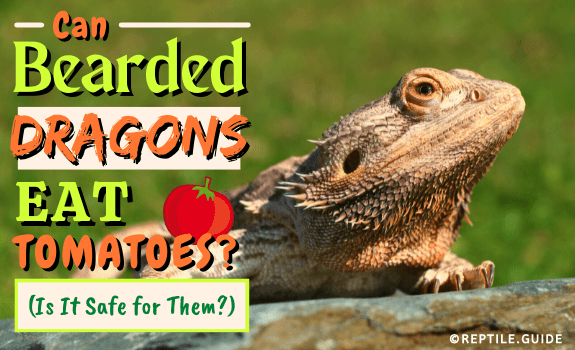Can bearded dragons eat tomatoes? Yes, they can, but only in small amounts and not more than once a month.
Tomatoes contain a large amount of acid, and the wrong ratio of Calcium to Phosphorus, which limits how often you can feed them to dragons.
However, tomatoes are a goldmine of micronutrients and minerals, so still make a good addition to your pet’s diet.
Join us as we delve into the depths of feeding tomatoes to your bearded dragon.
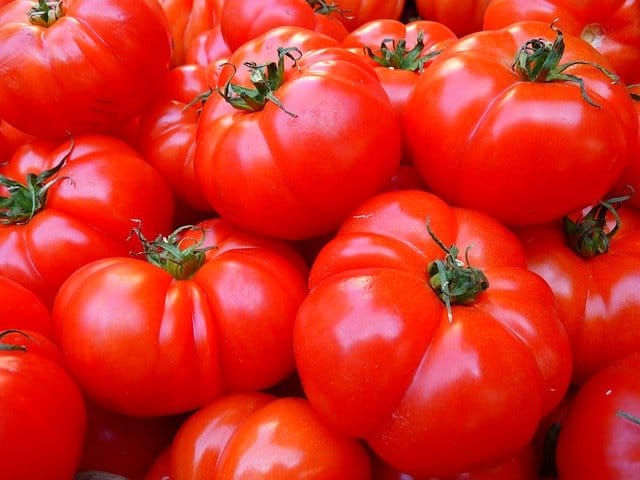
In This Article
In Short
- Can bearded dragons eat tomato worms? Yes, they can.
- Can bearded dragons eat tomato leaves? NO, tomato plants are toxic.
- Can bearded dragons eat green tomatoes? No, green tomatoes are toxic to dragons.
- Bearded dragons can eat tomato seeds, but it’s better to remove them (choking/compaction risk).
- Can bearded dragons eat tomatoes? Yes, about one-quarter of a tomato once a month or two grape tomatoes a month.
Can Bearded Dragons Eat Tomatoes?
Bearded dragons can eat tomatoes, but they shouldn’t do so more than once a month.
People often have concerns when it comes to feeding tomatoes to bearded dragons. Many keepers want to know if bearded dragons can eat tomatoes.
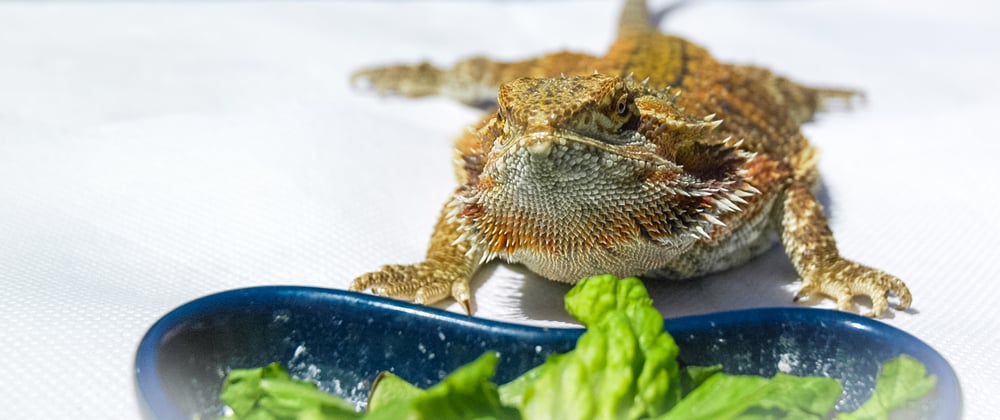
As is usual when combining the words, “bearded dragon” and “fruit” the answer is “Yes, but”.
Once a month is as often as is safe.
You should never give your bearded dragon more than a few small pieces. Bearded dragons can eat roughly one-quarter of a tomato per month.
Tomatoes contain high amounts of acid and the wrong ratio of calcium to phosphorous, which can lead to health concerns for your beardie (more about that later).
Always buy organic tomatoes, because pesticides can be lethal to bearded dragons.
Never give your beardie green tomatoes; they contain a toxic chemical.
How Do I Feed Bearded Dragons Tomatoes?
Follow these steps when feeding your bearded dragon tomatoes:
- Wash the tomato thoroughly.
- If it’s a full-sized tomato, cut it into quarters and select one quarter. If you’re using grape tomatoes, cut two of them into quarters.
- If you’re using a full-sized tomato quarter, peel it. If you’re using grape tomatoes, there’s no need.
- Remove all the seeds with a teaspoon, and rinse the inside of the tomato under the tap to ensure that you’ve removed all the seeds.
- Cut the tomato into pieces about the size of an M&M.
Most bearded dragons love tomatoes, and they make a welcome addition to a bearded dragon’s diet.
It’s important to prepare tomatoes in the right way if you want your bearded dragon to get the health benefits rather than the negative aspects.
We don’t recommend feeding fresh tomatoes on their own.
While they offer plenty of health benefits, it’s best to offer them as part of a salad that can help maintain a balanced diet.
We suggest mixing the tomato pieces with leafy greens like mustard greens and spinach.
Having a nice food bowl for your bearded dragon can make things a lot simpler since you can easily toss together a “salad” in the bowl before adding it to the enclosure.
Bearded dragons need a lot of calcium. Remember to dust the salad with a high-quality calcium supplement before offering it to your dragon.
Can Bearded Dragons Eat Cherry Tomatoes?
Bearded dragons can eat cherry tomatoes. They may make it easier to give the bearded dragon no more than its quota.

Cherry tomatoes have a similar nutrient value as a larger type of tomato, and all the usual rules apply.
Cherry tomatoes contain larger amounts of minerals and nutrients per portion size.
The major difficulty with feeding cherry tomatoes to your bearded dragon is that it can be difficult to remove all the seeds.
Of course, the amount of seeds largely depends on the type of cherry tomato.
If you choose to use one of the larger types of cherry tomato (grape tomatoes), it will be easy to cut the fruit into quarters and scoop out the seeds.
One nice thing about grape tomatoes is that their skins are much softer than that of large tomatoes. You can safely feed them to your bearded dragons without peeling them
You can safely include two grape tomatoes in your beardie’s diet every month.
Can Baby Bearded Dragons Eat Tomatoes
Baby bearded dragons can safely eat tomatoes, but you should give them even less than you’d give an adult.
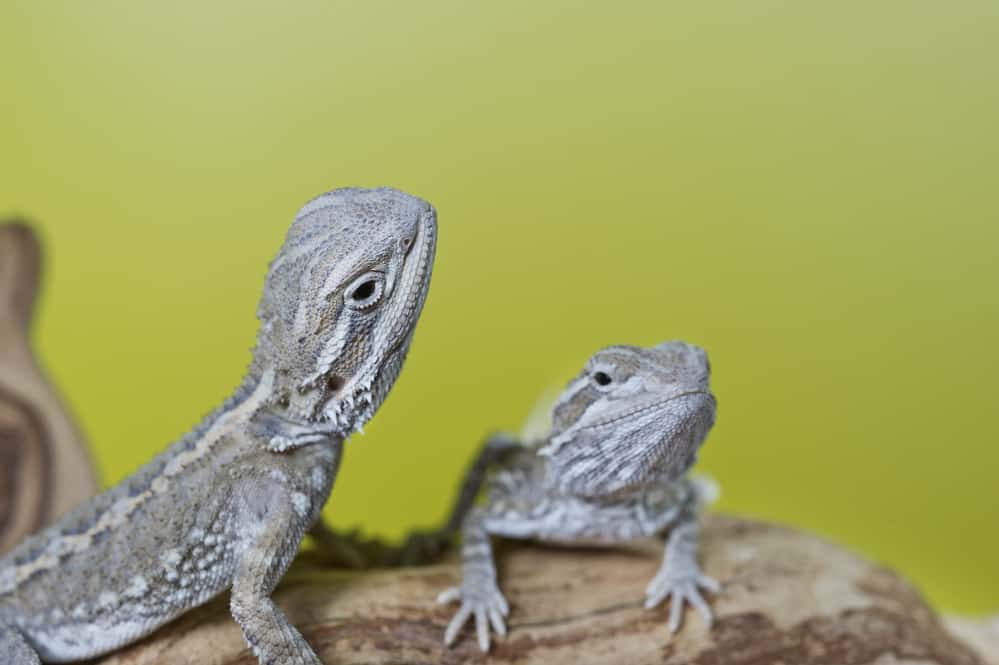
You can give your baby bearded dragon one small piece (about the size of an M&M) of tomato every two weeks. You can increase the amount you give them as they age.
Nutritional Value of Tomatoes
There’s a lot of nutritional value in a tomato, and one medium-sized (approximately 100 grams) tomato holds many minerals and nutrients.
According to the USDA, you can expect to find the following in a medium-sized Roma tomato:
- 94.7 grams of water
- 10 milligrams of Calcium
- 0.1 milligrams of Iron
- 8.1 milligrams of Magnesium
- 19 milligrams of Phosphorus
- 193 milligrams of Potassium
- 2.5 milligrams of Sodium
- 17.8 milligrams of Vitamin C
- 0.079 milligrams of Vitamin B-6
- 24 micrograms of Vitamin A
A 100g serving of grape tomato, according to the same source, holds around:
- 92 grams of water
- 11 milligrams of Calcium
- 0.33 milligrams of Iron
- 11.9 milligrams of Magnesium
- 28 milligrams of Phosphorus
- 260 milligrams of Potassium
- 6 milligrams of Sodium
- 27.2 milligrams of Vitamin C
- 0.06 milligrams of Vitamin B-6
- 0 micrograms of Vitamin A
Benefits of Feeding Bearded Dragons Tomatoes
Unripe tomatoes are toxic (just a reminder) but a ripe tomato can add invaluable nutrients to a beardie’s diet. What are tomatoes good for? Let’s have a look:
- Tomatoes have a high Vitamin A content.
Vitamin A is a vital element for growth and reproductive health, among other things.
Regular tomatoes contain up to 22 milligrams of Vitamin A in every 100 grams of tomato.
It’s vital to note that grape tomatoes have somehow missed out on the abundance of Vitamin A.
If you’re feeding tomatoes to your bearded dragon for the Vitamin A content, go for regular tomatoes.
Conversely, grape tomatoes have higher contents of just about every other nutrient.
- Tomatoes have much lower sugar contents than most other fruits.
A big problem with most fruits is that they have extreme sugar levels.
Sugar is a waste product for bearded dragons, and there are many health risks associated with it.
Tomatoes have a low sugar content which means that they won’t contribute to issues like obesity, fatty liver, and diabetes.
- Tomatoes contain little oxalic acid.
Oxalic acid is a common acid in many fruits, leaves, and flowers.
When consumed in large amounts, this substance can prevent the body from metabolizing calcium.
In an animal that relies heavily on a sufficient calcium intake, this can create a serious problem.
Tomatoes naturally contain much lower levels of oxalic acid than some fruits and vegetables, which makes them a good addition to your dragon’s diet.
- Tomatoes contain loads of minerals and micronutrients.
These fruits contain high amounts of many micronutrients and minerals which are often absent from other fruits and vegetables.
The sheer amount of antioxidants alone make tomatoes an excellent treat for your beardie.
Noteworthy mineral contents include Iron, Magnesium, and Potassium.
Disadvantages of Feeding Bearded Dragons Tomatoes
While many consider tomatoes to be nutrient-dense foods that help preserve reproductive health and the immune system, they have their disadvantages. Let’s have a look:
- Tomatoes contain a large amount of water.
While water may not seem like a particularly problematic ingredient, since we all need it to survive, it can be a problem.
The problem isn’t that these fruits contain water, but that they contain a lot more water than nutrients.
Bearded dragons don’t eat as often as some other animals, and it’s best if their food is packed with useful nutrients.
For a desert species like the beardie, water is vital but they need less of it. As a result, a large percentage of the tomato becomes a waste product.
- Tomatoes contain citric acid.
While dragons have relatively tough stomach linings, they can still deal with the problems that come from ingesting too many acidic foods.
In the desert, beardies don’t get exposed to as much citric acid as they do in captivity.
As with humans, these lizards can suffer from both indigestion and acid reflux if they eat too many acidic foods.
There is a plus side to a tomato’s oxalic acid levels, though (check the previous heading).
- Tomatoes have a low calcium content.
We’ll discuss the consequences of the wrong calcium to phosphorus ratio a little later.
Every bearded dragon owner knows that calcium is an essential part of a dragon’s diet.
While dragons can eat tomatoes, they have a comparatively low calcium content.
Feeding too many foods with a lack of this mineral can lead to calcium deficiency. In beardies, this condition can be fatal.
- Too much tomato can cause a Vitamin A overdose
Tomatoes contain a certain amount of Vitamin A, but they also contain beta carotene.
Once ingested, beta carotene starts to convert into Vitamin A inside a beardie’s body.
A small amount of the substance is required to keep everything functioning normally.
Too much Vitamin A becomes toxic and can cause unpleasant side effects like listlessness, dehydration, and weight loss.
We know we said the Vitamin A content was a good thing, and it is, but you know about too much of a good thing.
Ensure that your beardies have a balanced diet, and don’t give them tomatoes too often.
Metabolic Bone Disease
One of the major disadvantages of feeding bearded dragons fruit like tomatoes is that they generally have the wrong calcium ratio.
Bearded dragons need a balanced diet that contains more phosphorus than calcium.
For growing bearded dragons the ratio should be two parts calcium to one part phosphorus.
For adults, the dragon’s diet should include 1.5 parts calcium to one part phosphorus.
When a bearded dragon doesn’t eat enough calcium-rich foods, the resulting calcium deficiency can lead to Metabolic Bone Disease (MBD).
While a calcium deficiency might not sound like a big deal, MBD is a VERY big deal.
Symptoms of this crippling disease include:
- Swelling in the lower jaw
- Soft and malformed facial bones
- Swollen hind legs
- Leg tremors
Bearded dragons with the metabolic bone disease often have a compromised immune system which makes them more susceptible to other diseases.
Since their bones are so soft and brittle, dragons with MBD suffer bone fractures and broken bones for relatively minor bumps.
Your bearded dragon’s diet must contain the appropriate calcium to phosphorus ratio.
How Often Can Bearded Dragons Eat Tomatoes?
It’s best to only give your bearded dragon one-quarter of a tomato once a month, or two to three grape tomatoes.
You can also break the same amount of tomato down over a longer timeframe. For example, you could give your bearded dragon one-sixteenth (a quarter of a quarter) every week.
You could also give your bearded dragon one-half of a grape tomato every week.
In short, you should give your bearded dragon no more than one-quarter of a large tomato in a 30-day window.
How you choose to break that quarter tomato down during the month is up to you.
Fruits, like tomatoes, aren’t a food source that bearded dragons should get all the time. Their diet consists largely of protein and vegetables like leafy greens.
Can Bearded Dragons Eat Tomato Leaves?
You should never feed your bearded dragons any part of the tomato plant except the fruit. Tomato leaves, stems, and flowers are toxic and can KILL your dragon.
The tomato plant is in the nightshade family. While many nightshades offer edible fruits, roots, or tubers, the plants themselves are usually toxic.
Just like tomato leaves, green tomatoes contain solanine, which is toxic. Only ever feed your bearded dragon ripe tomatoes.
Can Bearded Dragons Eat Tomato Worms?
If you grow or know someone who grows tomatoes without using pesticides then you can feed the tomato worms to your bearded dragon.
Tomato hornworms are a significant pest on tomato plants.
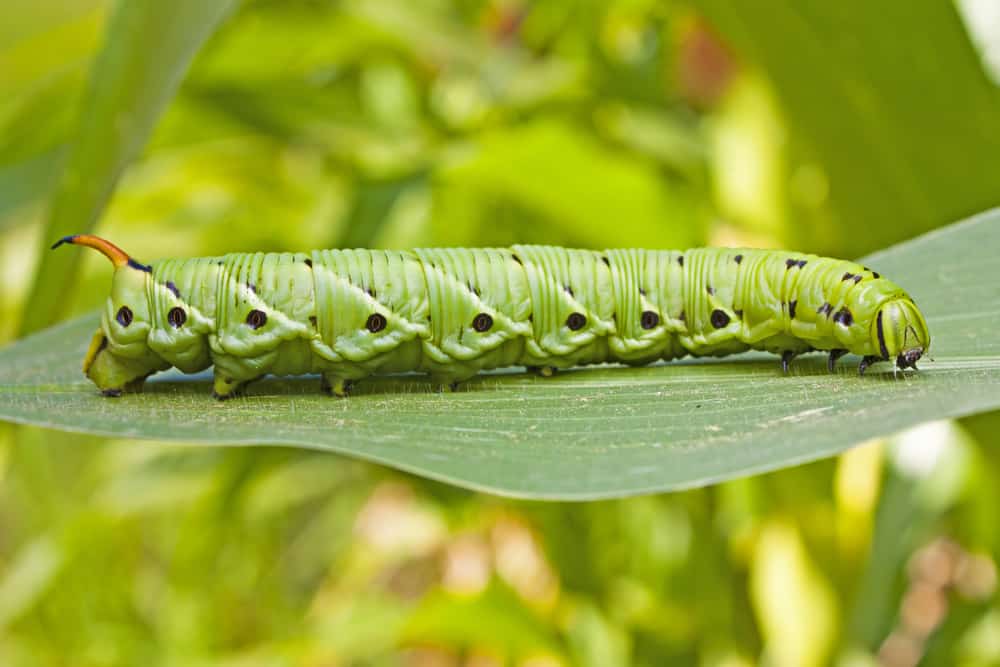
They also happen to be an excellent source of protein.
While bearded dragons can eat tomato worms, these worms shouldn’t make up more than a percentage of the dragon’s overall protein intake.
You can safely feed tomato worms to your dragon once or twice a week. Remember to dust them with a calcium supplement as you would other live foods.
Can Bearded Dragons Eat Tomato Seeds?
While tomato seeds aren’t toxic, it’s a good idea to remove them before feeding your bearded dragon tomatoes.
Bearded dragons are high-risk animals when it comes to choking hazards. They choke easily, and tomato seeds may also cause compaction.
Most bearded dragon owners remove all the seeds before they feed tomatoes to their bearded dragons.
While we can’t say that tomato seeds WILL kill your bearded dragon, why take the risk?
Which Other Fruits Can a Bearded Dragon Eat?
Tomatoes are only one of the many fruits that you can add to your beardie’s diet as a supplementary food source.
Here are a few everyday fruits that your beardie can munch on as well:
- Apple
- Banana – only as a treat
- Blackberries
- Cherries -but only rarely as a treat
- Figs
- Grapes
- Mango
- Papaya
- Peaches
- Strawberries
- Watermelon – as a rare treat
While there are many fruits that your beardie can safely eat, it’s vital to remember that most of them contain plenty of sugar.
Most of your bearded dragon’s diet should consist of vegetables, especially leafy greens, followed by live foods. Fruits should only make up around one-fifth of their overall diet.
We suggest feeding fruits around once a week and then varying the type every week.
There are plenty to choose from, and the different nutritional values of the different types all contribute something to a balanced diet.
Vegetable Pop Quiz for Bearded Dragons
While tomatoes are technically a fruit, many people believe that it’s a vegetable.
Since vegetables are an essential part of your bearded dragon’s diet, we’ve put together a brief pop quiz to answer some of the most common questions:
- Can Bearded Dragons eat cabbage? Red or green cabbage makes a good occasional meal for beardies.
- Can Bearded dragons eat broccoli? Broccoli is high in Calcium, but has too much water content. It’s good for a meal about once a month or to rehydrate a dehydrated beardie.
- Can Bearded dragons eat beetroot? Beardies can eat beetroot once monthly. It has a very high oxalic acid content which can be harmful to your lizard.
- Can bearded dragons eat carrots? Yes, they can! You can feed your beardie carrots once or twice a week.
- Can bearded dragons eat celery? A couple of small pieces once a week.
- Can bearded dragons eat peas? Peas make a good treat as they’re high in protein. They’re also high in sugars, so only good once every two weeks or so.
- Can bearded dragons eat beans? Beans are an excellent food source. Beardies can eat both the beans themselves and the leaves of the plant.
Speaking of fruits that get mistaken for vegetables, we’d like to offer a word of warning about cucumbers.
Cucumbers offer poor nutritional value and contain more water than nutrients.
If you have a beardie that loves cucumber, it can be useful for rehydrating them if they’re sick or dehydrated. It’s not a useful food, though, and you’d be wise to avoid it.
Pro Tip: Apart from leafy greens, most fruits and vegetables are only healthy in small amounts.
Keep a diary with the things you feed your dragon, and keep track of which foods you can feed when.
Plan a diet in advance so you can schedule different monthly, bi-weekly, and weekly foods for different days and weeks.
In addition to the standard live foods and leafy greens, this approach will allow you to safely feed more variety.
Have a look at our list of safe plants for bearded dragons for other feeding ideas.
We hope you’ve enjoyed this article about when and how to give your bearded dragon tomatoes.
If you’re new to the bearded dragon community, we have plenty of other articles that can help you. Check out our comprehensive care guide for general care information.
For more guidance about feeding, have a look at the article about how often to feed a beardie.
Perhaps you have a bearded dragon that stays skinny. Our how to make a bearded dragon gain weight article can help.
What’s your beardie’s favorite food? Let us know in the comments.
